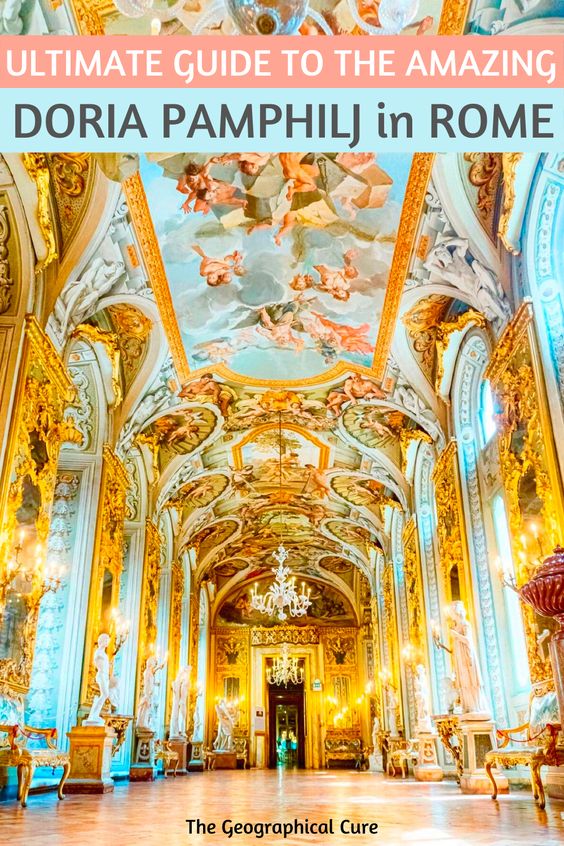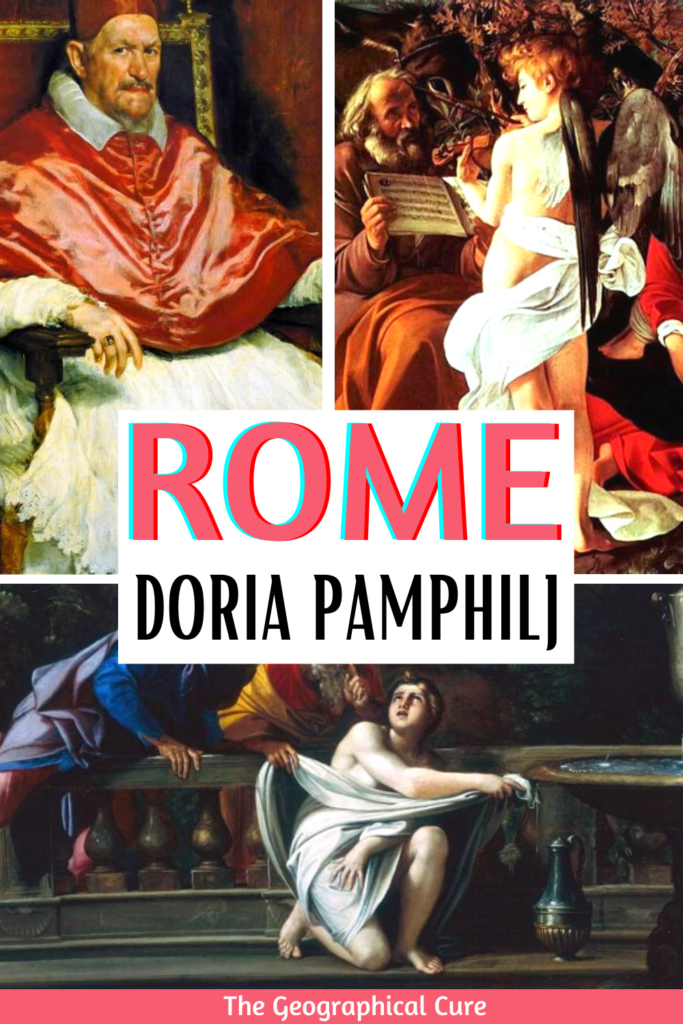Here’s my guide to visiting the under-appreciated and art-filled Doria Pamphilj Gallery in Rome.
This lovely museum was one of my absolute favorite spots in Rome. It’s a hidden gem housed in a lavish 17th century Roman-Rococo palace.
The remarkable art collection was meticulously assembled and is still owned by a powerful Italian family, the Doria Pamphilj (pronounced Pom-fee-lee).
The museum boasts over 650 works spanning the 15th to the 18th century, including pieces by Bernini, Caravaggio, Velazquez, Titian, Carracci, and Bruegel.
Apart from the art, the palace itself is a stunner. Every inch of the walls and ceilings are decorated with beautiful frescos, tapestries, and chandeliers.

A true art lover will be utterly delighted by this museum experience. It’s so rare to enjoy in situ art in its original historic setting, a yesteryear type experience.
And there’s no crowds. You can admire the art in peace and quiet without being jostled by crowds and selfie sticks.
Click here to book a skip the line ticket. The museum has such a wealth of history and art that you may want to book a guided tour.
History of the Doria Pamphilj
The gallery’s story begins with Camillo Pamphlij. Smitten with love, he married a wealthy widow, Olympia Aldobrandini.
To do so, he relinquished the cardinalship given to him by his uncle Giovanni Battista Pamphilj, Pope Innocent X. Neither the pope nor Camillo’s interfering mother were overly pleased.
The couple moved into what was then called the Aldobrandini Palace, which was part of Olympia’s dowry. Camillo straight away set to expanding the modest residence. He bought up buildings, demolishing them or bolting them into a single facade.
He also got busy purchasing paintings and statues from artists and intermediaries. Among other pieces, he acquired several Caravaggios and a Velazquez.
One of the couple’s daughters, Anna Pamphlij, married the aristocrat Giovanni Andrea III Doria Landi. That prompted the fusion of the two names. The family carried out significant restoration on the palace in the 18th century.
The Doria Pamphlij opened as a museum in 1950. Despite its partial conversion into a museum, members of the family still live in the palace.
The free audio guide is narrated in perfect English, rather whimsically, by Doria Pamphlij heir Prince Jonathan. He regales you with family tales, as well as describing the art.
READ: Guide To Rome’s Secret Palace Museums
Jonathan Doria Pamphlij lives with his gay partner and children in just 10 of the 1,000 rooms of the palace. And there’s some palace intrigue. His religious sister, Princess Gesine, challenged the legal status of his adopted children as heirs to the estate, estimated at over a billion dollars.
There was some irony in her drastic action. Jonathan and Gesine were each adopted from England by the sole heir Orietta Doria Pamphilj, Principessa di Melfi. Gesine lost her court battle, but still lives in the family seat in a separate wing.
Prince Jonathan hasn’t collected art himself. He views himself as a guardian. He’s done some redecorating and renovation, inspired by the Isabella Stewart Garner Museum in Boston (housed in a Venetian palace). The palace is currently in the hands of a trust to avoid Italian inheritance taxes and lineage complications.
Guide To The Doria Pamphilj: What To See
The palace has over 1,000 rooms. The main gallery of the museum is made of four hallways that surround a courtyard filled with lemon trees.
Your tour begins in the bold red reception hall, known as the Poussin Room. Every inch is wallpapered with landscape paintings specially commissioned to fit the walls and curves of the room.
They were painted by Gapard Dughet. He was known as “Poussin” because he was related the the famous Neo-Classical painter Nicholas Poussin.
In the adjoining Throne Room, you’ll find a portrait of Pope Innocent X by Pietro Neri. The throne faces the wall and is only turned around during papal visits, a tradition of Roman aristocratic families.
Then you stroll in the glamorous Velvets Room. This room is covered in Genoese velvet wall fabrics, likely dating from the 17th century. There are two fabulous busts by Alessandro Algardi, one of Benedetto Pamphilj and one of Innocent X.
The next grand room is the Ballroom. It was formerly named the Music Room. It once hosted music by composers such as Scarlatti and Handel.
In a 1903 renovation, its walls were covered in silk. One of the Ballroom’s most stunning features is the crystal wall sconces, originally gas and now electrified (and incredibly hard to photograph).
The ceiling once featured a beautiful and enormous canvas by Giuseppe Botani, the Apotheosis of Hercules. But it was damaged by a leak.
A draft of it is displayed in the small orchestra stall tucked away in a corner where you’ll see uniformed musicians and antique instruments. You can almost imagine the music playing.
Now the ceiling has a beautiful blue water color painting, the Doves of the Pamphilj Coat of Arms.
Have a peak into the Yellow Room, decorated by Venetian architect Filippo Bettini and filled with Gobelin tapestries.
Then admire the palace chapel, designed by Carlo Fontana. The colorful fresco, the Crowning of the Virgin, gives the illusion of a dome topped basilica. On display is an unusual reliquary — the mummified head of one of the family saints.
Masterpieces of the Doria Pamphilj
Now, for the main event. The next rooms are the grandest part of the palace — the four vaulted wings.
These gilded wings contain the most impressive artworks in the entire palace. Renowned Italian architect Gabriele Valvassori decorated them between 1731-34.
The paintings are all in their original position from the 18th century. This was thanks to a manuscript in the archives dated 1767, which pinpointed their location.
1. The Aldobrandini Gallery, the First Wing
This wing holds the family’s most precious paintings, along with priceless archeological artifacts. At the beginning of the hall, you’ll find Bernini’s bust of Innocent X. The initial bust Bernini created developed a crack. Legend hold that he reproduced the bust in just one week.
Paintings you shouldn’t miss in this wing include: (1) Landscape with the Flight into Egypt by Annibale Carraci, considered a classic of 17th century landscape painting, (2) Galatea by Giovanni Lanfranco, (3) Erminia Finds Tancredi Wounded by Guercino, and (4) View of Delphi with Procession by Claude Lorrain.
Halfway down the gallery you’ll find the bust of the family matriarch, Olympia Aldobandini Pamphilj, created by Giovanni Carrara in the late 17th century.
2. Velazquez Chamber
The emblem of the Doria Pamphilj collection is Velazquez’ Portrait of Pope Innocent X.The painting has its own dedicated room.
Created at the height of Velazquez’ powers, the portrait is famed for its psychological acuity and extreme naturalism. The pope’s fierce expression and glowering eyes led to him being considered despotic. But the portrait created commissions for Velasquez.
Jonathan Doria Pamphilj describes the painting as “a turning point in the history of Western art.” It’s not a heraldic noble depiction.
The painting is human. It shows both vulnerability and strength. You see “the man in all his layers.” When the Pope first saw the picture of himself, he didn’t appreciate its realism.
Velazquez’ painting inspired Francis Bacon’s famous Screaming Popes series from the 1950s. Bacon was fascinated by the painting’s distillation of power and imperious serenity. As an atheist, he rendered the image unholy, in an intentionally blasphemous fashion.
3. Gallery of Mirrors, the Second Wing
The Gallery of Mirrors is stunning. It’s inspired by the Hall of Mirrors at Versailles. It also reminded me of the Grand Foyer in the Opera Garnier in Paris.
This hall is lined with incredible gilt Venetian mirrors alternating with antique statues. The delicate frescoed ceilings of this room were painted by Bolognese artist Aureliano Milani.
Each scene illustrates a part of the Stories of Hercules epic. The Pamphilj family believe they descended from the mythological hero.
4. The Pamphilj Gallery, the Third Wing
This wing used to house the Portrait of Innocent X. And there’s a copy of it in its former place.
The wing contains several significant 16th century paintings. You can admire Correggio’s Allegory of Vice, which is similar to the one in the Louvre.
The Penitent Magdalen by Fetti (above) is an impressive and evocative portrait. Right next to Fetti’s work is the Penitent Saint Jerome by Lorenzo Lotto.
There’s also the Battle in the Porto of Naples by Pieter Bruegel the Elder. This work is a rare proof that Bruegel was in Italy for 5 years between 1550 and 1555.
5. The Doria Gallery, the Fourth Wing
Gracing the entrance of the Doria Gallery is one of the most famous sculptures of Alessandro Algardi, the bust of Olympia Maidalchini Pamphilj, the mother of Camillo. Her distinctiveness and strong-minded character are on full display in this striking sculpture.
The key paintings in this wing are the Madonna with the Child and Animals by Bruegel the Elder, Bruegel’s Allegory of Fire, and Madonna with the Child by Parmigianino.
6. Aldobrandini Room
This room is overwhelming. It’s filled to the brim with priceless masterpieces. You’ll find large scale paintings, classical statues, and antique reliefs.
Many of the sculptures in the room were from the Doria Pamphilj gardens and moved inside to protect them.
Many pieces in this room were part of the ancient Aldobrandini collection, passed down to the Pamphilj family after Camillo’s marriage to Olympia.
An important piece from this era is Raphael’s austere Double Portrait. No one knows, conclusively, who the two men are.
On the main wall, there are paintings by Bassano and Lotto. The key piece is a work by Titian, Salome with the Head of John the Baptist.
There’s also an copy of an ancient painting, The Aldobrandini Wedding, which was discovered in 1601 in the Esquiline. The original is in the Vatican Museums.
Then, there are two masterpieces by a young Caravaggio: Penitent Magdalene and Rest on the Flight into Egypt. Caravaggio may have used the same model for both paintings. The sorrowful Magdalene is portrayed alone in an empty room.
Practical Guide & Tips for the Doria Pamphilj:
Address: Via del Corso 305
Metro: Take Line A and get off at Piazza Barberini]
Hours:
From Monday to Thursday the gallery is open from 9:00 am to 7:00 pm (last entry at 6:00 pm). On Friday to Sunday, it’s open from 10:00 am to 8:00 pm.
Most museums in Rome are closed on Mondays. The Doria Pamphilj isn’t, something to keep in mind.
Entry fee: 14 €, free audio guide
Pro tips: There’s not much seating in the gallery and no elevator.
I hope you’ve enjoyed my guide to the Doria Pamphilj. You may enjoy these other guides to art in Rome:
- 8 Ways To Spend 1 days in Rome
- 3 Days in Rome Itinerary
- 5 Days In Rome Itinerary
- Hidden Gems in Rome
- Rome’s Palace Museums
- Bernini Guide to Rome
- Caravaggio Guide to Rome
- Guide to the Best Museums in Rome
- Guide To the Doria Pamphilj Gallery
- Must See Archaeological Sites & Ruins
- 50 Facts About Rome
If you’d like to visit the Doria Pamphilj, pin it for later.

